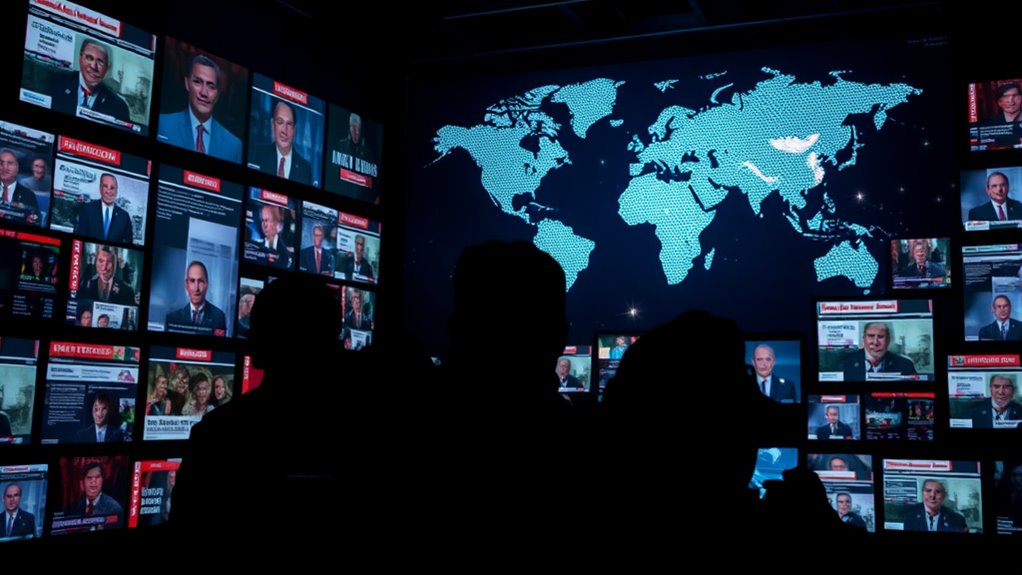In the realm of AI disinformation wars, state actors exploit advanced technologies to manipulate information and erode trust. With AI-generated deepfakes and bot armies, false narratives spread rapidly, complicating detection and accountability. Regulatory efforts are evolving to combat these challenges, but jurisdictional issues remain. To effectively navigate this landscape, you need to enhance your media literacy and critical thinking skills. There's much more to uncover about the implications for democracy and how you can stay informed.
Key Takeaways
- State actors leverage AI technologies for espionage, complicating the landscape of truth and accountability in information dissemination.
- Regulatory efforts, such as fines for spreading disinformation, aim to hold platforms accountable but face jurisdictional challenges.
- Traditional detection methods struggle to identify AI-generated misinformation, leaving a gap in policing truth in espionage contexts.
- Collaboration among governments, tech companies, and civil society is essential for developing effective strategies against disinformation campaigns.
- Enhancing public awareness and media literacy is crucial for empowering individuals to discern credible information amidst AI-driven disinformation.
The Impact of AI on Disinformation Campaigns

As AI technology continues to evolve, it significantly amplifies the impact of disinformation campaigns, making them more pervasive and sophisticated.
AI tools lower the barrier for creating and spreading false information, allowing various actors to craft convincing deceptions with ease. Generative AI produces deepfakes—realistic fake texts, images, audio, and videos—that are increasingly hard to distinguish from authentic content. Meanwhile, AI-driven bot armies can amplify these narratives quickly and cheaply, blurring the line between reality and falsehood. This sophistication not only targets specific demographics but also fosters skepticism toward genuine information, complicating public discourse. Global internet freedom has declined for the 13th consecutive year, further complicating the climate in which these disinformation campaigns thrive.
With these advancements, the spread of disinformation becomes a formidable challenge, undermining trust in institutions and eroding the foundations of informed decision-making.
State Actors and the Use of AI in Espionage

With the rise of sophisticated AI technologies, state actors are increasingly harnessing these tools to enhance their espionage efforts. They're automating attacks and refining social engineering tactics, making their operations more effective. AI and LLMs are used to automate attack phases, allowing these actors to streamline their processes and increase the overall sophistication of their cyber operations. AI-driven malware evolves rapidly, outpacing traditional defense systems, while geopolitical tensions spur destructive cyberattacks aimed at critical infrastructure. Nation-state actors often collaborate with cybercriminals, blurring the line between state and non-state actors, which complicates attribution and provides plausible deniability for their actions. By analyzing vast datasets, AI identifies vulnerabilities and targets efficiently, enabling more sophisticated phishing campaigns. Countries like Russia, China, North Korea, and Iran leverage AI to conduct influence operations, further heightening global security risks. It's a new frontier in the espionage landscape.
Challenges in Detecting AI-Generated Misinformation

Detecting AI-generated misinformation poses significant challenges, particularly due to the sophistication of the content produced.
AI tools create highly realistic images, videos, and audio that often blend seamlessly with authentic material. Traditional detection methods struggle to keep pace with these advancements, leaving you vulnerable to misinformation. As AI capabilities evolve rapidly, staying ahead of new forms of deception becomes increasingly difficult. Legal and ethical complexities further muddy the waters, complicating accountability for creators. Additionally, advanced AI systems analyze patterns, language, and context to combat misinformation, offering potential solutions to these challenges.
Public awareness is crucial; enhancing media literacy helps you critically evaluate information. Without effective strategies like blockchain verification or watermarking, distinguishing real from fake content remains a daunting task, jeopardizing trust in information integrity and impacting societal discourse.
Regulatory Efforts to Combat Disinformation

While the rise of AI-generated disinformation presents serious challenges, regulatory efforts are underway to combat its spread.
Governments are enacting legislation that imposes fines and even criminal penalties on those spreading false information. For example, Germany can fine platforms up to €50 million for failing to remove illegal content. A majority of Americans rely on various media sources for election information, which underscores the importance of these regulations.
Content moderation policies are being implemented, with international cooperation seen in frameworks like the EU Code of Practice on Disinformation. However, enforcing these regulations can be tricky due to jurisdictional issues.
Moreover, some measures risk infringing on free speech rights. To maximize effectiveness, policymakers need to adopt a holistic approach, combining legal, educational, and technological strategies to create a robust defense against disinformation.
Enhancing Public Awareness and Media Literacy

Regulatory efforts alone can't fully address the challenge of AI-driven disinformation; enhancing public awareness and media literacy plays a vital role in empowering individuals to critically assess the information they encounter.
By integrating media literacy into educational curricula, you can develop skills to recognize and resist misinformation. Community programs can further foster discussions about disinformation techniques. Moreover, AI tools can democratize disinformation production, highlighting the importance of understanding how these systems operate. Recent advancements in natural language processing have improved the ability of AI to generate realistic text, making it even more crucial for individuals to discern credible information.
Integrating media literacy in education empowers individuals to identify and combat misinformation through informed discussions and community engagement.
Utilizing technological tools, like NewsGuard, helps identify credible sources in real time. Workshops and seminars for all ages can boost your critical evaluation skills.
Public awareness campaigns will reach broader audiences, encouraging engagement with media. Collaborative efforts among tech companies, governments, and civil society are essential to create accessible resources, ensuring everyone can navigate the complexities of information in today's digital landscape.
The Future of AI and Its Implications for Democracy

As technology evolves, the role of artificial intelligence in shaping democratic processes becomes increasingly significant. AI can enhance citizen engagement, making politics more accessible. However, it also poses serious risks, such as spreading disinformation that can manipulate public opinion and disrupt electoral integrity. The potential for foreign interference looms large, threatening the stability of democracies. Moreover, AI's surveillance capabilities raise concerns about privacy, undermining individual freedoms. To navigate these challenges, effective regulations and ethical frameworks are crucial. Proper safeguards are essential to harness AI's potential positively. Collaboration among governments, tech companies, and citizens is essential to ensure AI supports rather than undermines democratic values. Ultimately, the future of AI in democracy hinges on balancing innovation with responsibility and transparency.
Frequently Asked Questions
How Can Individuals Protect Themselves From Ai-Generated Misinformation?
To protect yourself from AI-generated misinformation, start by critically evaluating your information sources.
Don't just accept what you see; fact-check claims using reliable databases or known fact-checking websites.
Enhance your media literacy by engaging with educational content on recognizing misinformation.
Stay updated on AI technologies and their implications.
Additionally, discuss information with others to gain diverse perspectives, and always question unusual or sensational content before sharing it further.
What Are the Ethical Concerns Surrounding Ai-Generated Content?
Navigating the digital sea of AI-generated content can feel like sailing through fog; visibility's low, and dangers lurk.
You've got to be aware of the ethical concerns: biases in training data can distort reality, while misinformation can spread like wildfire.
Privacy's at risk, too, as sensitive info may slip through the cracks.
Plus, ownership issues leave you questioning who truly claims the content you see.
Stay informed to steer clear of these treacherous waters.
Are There Specific Examples of Successful AI Disinformation Campaigns?
Yes, there are specific examples of successful AI disinformation campaigns.
One notable case is Russia's "Storm-1516," which used AI to mimic legitimate news outlets and influence German elections.
Another example is the DoppelGänger Campaign, where AI cloned media websites to spread pro-Russian narratives across Europe.
Deepfake videos have also been effective in distorting political figures' images, undermining public trust and manipulating perceptions during crucial election periods.
How Do Different Countries Regulate AI and Disinformation?
As you explore how countries regulate AI and disinformation, you'll find a fascinating mix of approaches.
The EU's strict AI Act enforces transparency, while the US relies on state-level guidelines.
Meanwhile, nations like Brazil and South Africa develop their frameworks.
Coincidentally, global initiatives from the OECD and UN promote trustworthy AI principles.
Countries also impose penalties for non-compliance, each crafting its path to balance innovation and accountability in this evolving landscape.
What Role Do Social Media Platforms Play in AI Disinformation?
Social media platforms play a crucial role in combating AI-generated disinformation. They implement bot management solutions to identify and block suspicious activities, protecting their APIs from exploitation.
By collaborating with law enforcement, they disrupt large-scale disinformation campaigns. Additionally, they utilize AI for content moderation, helping to detect false information.
You can also promote media literacy among users, encouraging them to critically evaluate what they see online and recognize misleading content.
Conclusion
In this digital age, combating cunning disinformation demands dedicated diligence. As AI's influence grows, so must our guard against deceptive designs. By fostering a foundation of factual familiarity, we can empower individuals to discern truth from trickery. Governments, tech firms, and citizens alike must collaborate, creating a cohesive counteroffensive to safeguard democracy. Only through shared strength and steadfast strategies can we navigate this new frontier, ensuring a future where facts flourish and falsehoods falter.









